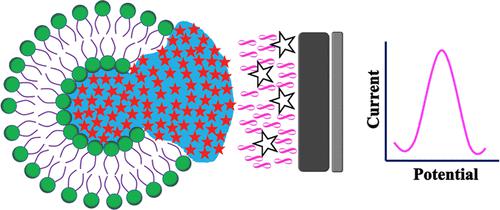Our official English website, www.x-mol.net, welcomes your
feedback! (Note: you will need to create a separate account there.)
Chemical Sensors Based on Molecularly Imprinted Polymers Can Determine Drug Release Kinetics from Nanocarriers without Filtration, Centrifugation, and Dialysis Steps
ACS Sensors ( IF 8.2 ) Pub Date : 2023-03-06 , DOI: 10.1021/acssensors.2c02436 Zeynab Soosani 1 , Behzad Rezaei 1 , Esmaeil Heydari-Bafrooei 1 , Ali A Ensafi 1, 2
ACS Sensors ( IF 8.2 ) Pub Date : 2023-03-06 , DOI: 10.1021/acssensors.2c02436 Zeynab Soosani 1 , Behzad Rezaei 1 , Esmaeil Heydari-Bafrooei 1 , Ali A Ensafi 1, 2
Affiliation

|
With the development of drug delivery systems, the use of nanomaterials for slow, targeted, and effective drug release has grown significantly. To ensure the quality of performance, it is essential to obtain drug release profiles from therapeutic nanoparticles prior to in vivo testing. Typically, the methods of monitoring the drug release profile from nanoparticle drug delivery systems include one or more filtration, separation, and sampling steps, with or without membrane, which cause several systematic errors and make the process time-consuming. Here, the release rate of doxorubicin as a model drug from liposome as a nanocarrier was determined via highly selective binding of released doxorubicin to the doxorubicin-imprinted electropolymerized polypyrrole as a molecularly imprinted polymer (MIP). Incubation of the MIP-modified substrate with imprinted cavities complementary to doxorubicin molecules in the releasing medium leads to the binding of released doxorubicin molecules to cavities. The drug trapped in the cavities is determined by one of the analytical methods depending on its signaling properties. In this work, due to the favorable electrochemical properties of doxorubicin, the voltammetry method was used for quantitative analysis of released doxorubicin. The voltammetric oxidation peak current intensity of doxorubicin on the surface of the electrode was enhanced by increasing the release time. This membranelle platform allows fast, reliable, and simple monitoring of drug release profiles without any sample preparation, filtration, and centrifugation in buffer and blood serum samples.
中文翻译:

基于分子印迹聚合物的化学传感器无需过滤、离心和透析步骤即可确定纳米载体的药物释放动力学
随着药物输送系统的发展,纳米材料在缓慢、靶向和有效药物释放方面的应用显着增加。为确保性能质量,必须在体内测试之前从治疗性纳米颗粒获得药物释放曲线。通常,监测纳米颗粒药物递送系统的药物释放曲线的方法包括一个或多个过滤、分离和取样步骤,有或没有膜,这会导致一些系统错误并使过程耗时。在这里,阿霉素作为模型药物从作为纳米载体的脂质体中的释放速率是通过释放的阿霉素与作为分子印迹聚合物 (MIP) 的阿霉素印迹电聚合聚吡咯的高度选择性结合来确定的。在释放介质中孵育具有与多柔比星分子互补的印迹空腔的 MIP 修饰底物导致释放的多柔比星分子与空腔结合。困在空腔中的药物根据其信号特性通过其中一种分析方法确定。在这项工作中,由于多柔比星有利的电化学性质,伏安法用于定量分析释放的多柔比星。阿霉素在电极表面的伏安氧化峰电流强度随着释放时间的增加而增强。这种膜平台允许快速、可靠和简单地监测药物释放曲线,而无需在缓冲液和血清样品中进行任何样品制备、过滤和离心。
更新日期:2023-03-06
中文翻译:

基于分子印迹聚合物的化学传感器无需过滤、离心和透析步骤即可确定纳米载体的药物释放动力学
随着药物输送系统的发展,纳米材料在缓慢、靶向和有效药物释放方面的应用显着增加。为确保性能质量,必须在体内测试之前从治疗性纳米颗粒获得药物释放曲线。通常,监测纳米颗粒药物递送系统的药物释放曲线的方法包括一个或多个过滤、分离和取样步骤,有或没有膜,这会导致一些系统错误并使过程耗时。在这里,阿霉素作为模型药物从作为纳米载体的脂质体中的释放速率是通过释放的阿霉素与作为分子印迹聚合物 (MIP) 的阿霉素印迹电聚合聚吡咯的高度选择性结合来确定的。在释放介质中孵育具有与多柔比星分子互补的印迹空腔的 MIP 修饰底物导致释放的多柔比星分子与空腔结合。困在空腔中的药物根据其信号特性通过其中一种分析方法确定。在这项工作中,由于多柔比星有利的电化学性质,伏安法用于定量分析释放的多柔比星。阿霉素在电极表面的伏安氧化峰电流强度随着释放时间的增加而增强。这种膜平台允许快速、可靠和简单地监测药物释放曲线,而无需在缓冲液和血清样品中进行任何样品制备、过滤和离心。











































 京公网安备 11010802027423号
京公网安备 11010802027423号